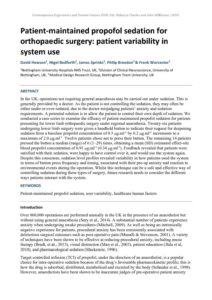| Document | Author David Hewson, Nigel Bedforth, James Sprinks, Philip Breedon & Frank Worcester |
| Abstract In the UK, operations not requiring general anaesthesia may be carried out under sedation. This is generally provided by a doctor. As the patient is not controlling the sedation, they may often be either under or over-sedated, due to the doctor misjudging patients’ anxiety and sedation requirements. A potential solution is to allow the patient to control their own depth of sedation. We conducted a case series to examine the efficacy of patient-maintained propofol sedation for patients presenting for lower limb orthopaedic surgery under regional anaesthesia. Twenty-six patients undergoing lower limb surgery were given a handheld button to indicate their request for deepening sedation from a baseline propofol concentration of 0.5 g.ml-1 by 0.2 g.ml-1 increments to a maximum of 2.0 g.ml-1. Twelve patients chose not to press their button. The remaining 14 patients pressed the button a median (range) of 6 (1–29) times, obtaining a mean (SD) estimated effect-site blood propofol concentration of 0.91 g.ml-1 (0.34 g.ml-1). Feedback revealed that patients were satisfied with their sedation, were happy to have control over it, and would use the system again. Despite this consensus, sedation level profiles revealed variability in how patients used the system in terms of button press frequency and timing, associated with their pre-op anxiety and reaction to environmental events during the operation. Whilst this technique can be a safe and effective way of controlling sedation during these types of surgery, future research needs to consider the different ways patients interact with the system. |

